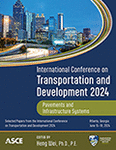Satellite and Street Imagery-Informed Calibration of Physics-Based Rainfall-Induced Slope Susceptibility Maps
Publication: International Conference on Transportation and Development 2024
ABSTRACT
Physics-based predictive models for identifying rainfall-induced slope susceptibilities typically consider slope geometry, soil type and properties, and precipitation. However, these models do not often account for the impact of land cover (e.g., retaining structures, vegetation, wetlands, and water bodies) on slope susceptibilities. The presence of retaining structures and vegetation can improve slope stability, while exposure of slope to water bodies can adversely degrade slope stability. Existing data sources, such as the US Department of Agriculture (USDA) and Texas Natural Resources Information System (TNRIS) databases, lack sufficient land cover information, making it challenging to derive the necessary data. The objectives of this research are to develop a satellite and street imagery-informed calibration method and integrate it with physics-based models to incorporate the effects of land cover on slope stability. The methodology comprises creating a formal workflow for collecting images along highway corridors through high-resolution satellite and street images, classifying the condition of land cover through assessment of these images, and developing the polygon feature layer representing the extent of different land covers. This method is integrated with an existing physics-based model by transforming the polygon feature layer into a raster file and conducting a raster overlay analysis of the slope susceptibility maps to update the susceptibility levels of slopes. This integration method was implemented along the highway corridors in Texas. Over 10,000 slope assessments were calibrated utilizing satellite and street imagery to identify instances of water-eroded and mechanically stabilized slopes. Consequently, the susceptibility levels in these locations were adjusted to account for the impact of the observed land cover conditions. This integration method enhances the accuracy of slope failure susceptibility maps, enabling transportation agencies to identify critical slope segments and plan proactive slope maintenance initiatives more effectively.
Get full access to this chapter
View all available purchase options and get full access to this chapter.
REFERENCES
Adhikari, I., Baral, A., Zahed, E., Abediniangerabi, B., and Shahandashti, M. (2021). Early stage multi-criteria decision support system for recommending slope repair methods. Civil Engineering and Environmental Systems, 38(2), 127–144.
Baral, A., and Shahandashti, S. M. (2022). Identifying critical combination of roadside slopes susceptible to rainfall-induced failures. Natural Hazards, 113(2), 1177–1198.
Baral, A., Poumand, P., Adhikari, I., Abediniangerabi, B., and Shahandashti, M. (2021). GIS-based data integration approach for rainfall-induced slope failure susceptibility mapping in clayey soils. Natural Hazards Review, 22(3), 04021026.
Baral, A., Sadegh Nasr, M., Darghiasi, P., Abediniangerabi, B., and Shahandashti, M. (2022). Detection and Classification of Vegetation for Roadside Vegetation Inspection and Rehabilitation Using Deep Learning Techniques. In International Conference on Transportation and Development 2022 (pp. 143–152).
Berti, M., and Simoni, A. (2010). Field evidence of pore pressure diffusion in clayey soils prone to landsliding. Journal of Geophysical Research: Earth Surface, 115(F3).
Collin, J. G., Loehr, J. E., and Hung, C. J. (2008). Slope Maintenance and Slide Restoration Reference Manual for NHI 132081 course.
D’Odorico, P., Fagherazzi, S., and Rigon, R. (2005). Potential for landsliding: Dependence on hyetograph characteristics. Journal of Geophysical Research: Earth Surface, 110(F1).
Gray, D. H. (1995). Influence of vegetation on the stability of slopes. In vegetation and slopes: stabilisation, protection, and ecology. Proceedings of the international conference held at the university museum, oxford, 29-30 September 1994.
Greenwood, J. R., Norris, J. E., and Wint, J. (2004). Assessing the contribution of vegetation to slope stability. Proceedings of the Institution of Civil Engineers-Geotechnical Engineering, 157(4), 199–207
Hosseini, M., Beiranvand, P., Mohammadiasl, M., and Ashkan, H. (2022). Influence of surface cracks on the stability of cracked soil slope. International journal for computational civil and structural engineering, doi: https://doi.org/10.22337/2587-9618-2022-18-4-82-90.
Iverson, R. M. (2000). Landslide triggering by rain infiltration. Water resources research, 36(7), 1897–1910.
Johnston, I., Murphy, W., and Holden, J. (2021). A review of floodwater impacts on the stability of transportation embankments. Earth-Science Reviews, 215, 103553.
Mohseni, O., Anderson, C., Strong, M., Conway, R., Hathaway, C., Grosser, A., and Mielke, A. (2018). Storm-induced slope failure susceptibility mapping. Minnesota. Dept. of Transportation.
Montgomery, D. R., and Dietrich, W. E. (1994). A physically based model for the topographic control on shallow landsliding. Water resources research, 30(4), 1153–1171.
Shahandashti, M., Hossain, S., Baral, A., Adhikari, I., Pourmand, P., and Abediniangerabi, B. (2022). Slope repair and maintenance management system. Texas. Department of Transportation.
Spiker, E. C., and Gori, P. (2003). National landslide hazards mitigation strategy, a framework for loss reduction (No. 1244). US Geological Survey.
Tang, L., Wang, L., and Zhang, W. (2019, September). Assessing the Stability of Poor Drainage Soil Slopes Under the Combined Effect of Water Level Drawdown and Rainfall. In IOP Conference Series: Earth and Environmental Science (Vol. 304, No. 4, p. 042024). IOP Publishing.
White, D. (2006). Innovative solutions for slope stability reinforcement and characterization.
Zhang, S., Zhao, L., Delgado-Tellez, R., and Bao, H. (2018). A physics-based probabilistic forecasting model for rainfall-induced shallow landslides at regional scale. Natural Hazards and Earth System Sciences, 18(3), 969–982.
Information & Authors
Information
Published In
History
Published online: Jun 13, 2024
Authors
Metrics & Citations
Metrics
Citations
Download citation
If you have the appropriate software installed, you can download article citation data to the citation manager of your choice. Simply select your manager software from the list below and click Download.
